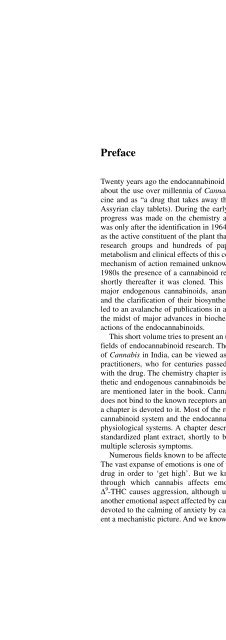3. Umbruch 4.4..2005 - Online Pot
3. Umbruch 4.4..2005 - Online Pot
3. Umbruch 4.4..2005 - Online Pot
Create successful ePaper yourself
Turn your PDF publications into a flip-book with our unique Google optimized e-Paper software.
Preface<br />
Twenty years ago the endocannabinoid system was unknown. We knew much<br />
about the use over millennia of Cannabis plant preparations both as a medicine<br />
and as “a drug that takes away the mind” (as so-well stated in ancient<br />
Assyrian clay tablets). During the early part of the last century considerable<br />
progress was made on the chemistry and pharmacology of Cannabis, but it<br />
was only after the identification in 1964 of ∆ 9 -tetrahydrocannabinol (∆ 9 -THC)<br />
as the active constituent of the plant that this field caught the interest of many<br />
research groups and hundreds of papers on the chemistry, biochemistry,<br />
metabolism and clinical effects of this compound were published. However, its<br />
mechanism of action remained unknown for nearly two decades. In the mid-<br />
1980s the presence of a cannabinoid receptor in the brain was identified and<br />
shortly thereafter it was cloned. This was followed by the isolation of the<br />
major endogenous cannabinoids, anandamide and 2-arachidonoyl glycerol,<br />
and the clarification of their biosyntheses and degradations. These advances<br />
led to an avalanche of publications in a wide variety of fields. We are now in<br />
the midst of major advances in biochemistry/physiology associated with the<br />
actions of the endocannabinoids.<br />
This short volume tries to present an up-to-date picture in some of the major<br />
fields of endocannabinoid research. The first chapter in this book, on the use<br />
of Cannabis in India, can be viewed as an expression of thanks to the herbal<br />
practitioners, who for centuries passed on the medical traditions associated<br />
with the drug. The chemistry chapter is a short summary of active plant, synthetic<br />
and endogenous cannabinoids being investigated today, many of which<br />
are mentioned later in the book. Cannabidiol is an unusual cannabinoid – it<br />
does not bind to the known receptors and yet exerts a variety of effects. Hence<br />
a chapter is devoted to it. Most of the remaining chapters deal with the endocannabinoid<br />
system and the endocannabinoids in a variety of conditions and<br />
physiological systems. A chapter describes the research done on Sativex ® ,a<br />
standardized plant extract, shortly to be introduced in Canada as a drug for<br />
multiple sclerosis symptoms.<br />
Numerous fields known to be affected by cannabinoids were not reviewed.<br />
The vast expanse of emotions is one of them. Most marijuana users smoke the<br />
drug in order to ‘get high’. But we know very little about the mechanisms<br />
through which cannabis affects emotions. Under certain circumstances<br />
∆ 9 -THC causes aggression, although usually it leads to sedation. Anxiety is<br />
another emotional aspect affected by cannabinoids. Although a short chapter is<br />
devoted to the calming of anxiety by cannabinoids it does not attempt to present<br />
a mechanistic picture. And we know next to nothing on the chemistry link-<br />
IX







